Can Burris optics handle difficult conditions? The best way to find out is to freeze them, frost them, dunk them, and otherwise put them through a gauntlet of difficult conditions. Last turkey season, Logan Holtz and I hunter turkey in late April when a sudden, full-boar blizzard struck. Temperatures fell into single digits, roads drifted shut and most sane people slept in and hunkered down, but not us. Holts works for Burris and he had a host of products that had to prove their mettle in these difficult conditions.
Wham Bam Opener
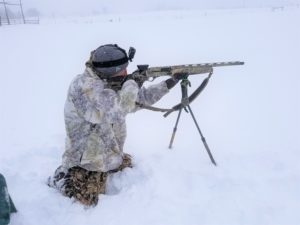
Hunting turkeys in a foot of blowing snow may sound crazy, but we had traveled a long way and wouldn’t be deterred. We anticipated the brutal weather would move birds back into their winter feeding patterns and using our 4WD vehicle, we drove to a secluded ranch and received permission to hunt near an old cattle feeding lot. Driving across a narrow two-track bridge was nerve-racking, yet we finally found the food lot and a huge flock of turkey and cattle mixed together.
“Let me out here,” said Holtz as the turkeys had just come into view. “I’ll sneak along this creek bottom. Why don’t you head as far as you can beyond the cattle?”
Pushing to get the frozen door open, Holtz stepped into the blizzard and disappeared while we eased forward toward the end of the road. Moving slowly we saw several big gobblers, yet they were mixed in with the cattle that seemed very nervous about our truck. We stayed in our vehicle so as not to spook the herd which could have been dangerous for everyone.
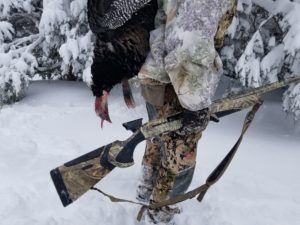 Circling back, we traveled several hundred yards where we found Holtz with two mature toms. Using his binoculars he was able to spot a segment of the flock separating from the cattle, make a stalk, and then bag two big toms with a single shot, thanks to his Fastfire III red dot sight. Wow, those Burris optics had performed.
Circling back, we traveled several hundred yards where we found Holtz with two mature toms. Using his binoculars he was able to spot a segment of the flock separating from the cattle, make a stalk, and then bag two big toms with a single shot, thanks to his Fastfire III red dot sight. Wow, those Burris optics had performed.
Good News, Bad News
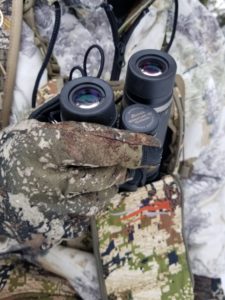
Mayhem ruled as Holtz put the gobblers, now snow-covered, in the back of the truck and we celebrated and prayed we could make it back to camp. His plan was to take one turkey with his shotgun and the new Fastfire III sight and try for a second with his bow and the Oracle self-ranging sight. His red dot sight allowed him to line up two big boss gobblers for a single shot; the bad news, both tags were filled.
Since I didn’t have a compound bow, I couldn’t test the Oracle, but Holtz left his binoculars and Fastfire III sight behind. Ironically, as brutal as the blizzard had been, the weather turned hot and sunny, transforming roads and fields that were blanket in snow to those caked in mud. The rapid melt transformed many creek bottoms, where turkey roosted and often fed into lakes with knee-deep pockets of water, a further test of Burris optics.
Fastfire III- My Turn
In two days conditions changed from knee-deep snow to water over my boots, one of the most drastic weather changes I’d seen. Turkeys often roost over water so the flooded bottoms didn’t change their roosting sites, but made approaching them much more of a challenge.
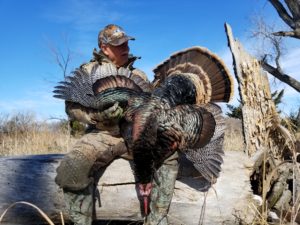
I was hunting with my good friend Ken Byers on the last morning of our hunt. As usual, we were near a creek bottom at dawn and heard several gobbles deep into the cottonwoods. We weren’t able to reach them before fly down, so soon it became a spot and stalk situation, a fairly normal tactic for Western turkey hunting. I had the Burris Signature HD 12×50’s which brought any movement into crystal clear view.
Turkeys were still in flocks and luring a tom away from hens proved difficult. We called and used a gobbler decoy, but with no success. My buddy Ken is a master of patience and instead of any rash moves, he kept calling and following the flock. We crawled through the mud and weeds for concealment and peeked through the brush with our binoculars.
Suddenly, Ken elbowed me and pointed to his right. Raising up slightly, I could see a gobbler fan approaching at 10 yards, but Ken was between the bird and I. Sliding ahead, I rested on one elbow, raised the shotgun, and aligned the red dot with the tom’s head. Boom! Tag filled.
Why Gear Makes a Difference
Despite the close range, this was one of the most difficult shots I’d made on turkeys. Because of the dense cover and angle of approach, I had to hold the shotgun like you see gangsters do in movies. With a standard bead sight, I’d have surely missed and mentally thanked Holtz for share his gear.
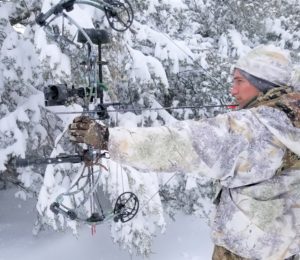
Weather changes can turn good gear into junk and I cherish the opportunity to try items in the field before buying them. At this writing, I’m setting up a crossbow for a Western elk hunt and the Fastfire III came quickly to mind. State regulations forbid traditional scopes and require zero magnification and one dot only.
Because the Fast Fire III is ideal for pistols, rifles, shotguns, and crossbows, I was lucky to get one. If you are thinking of adding red dot technology to your program for the coming season, jump onto the Burris optics website today. Items are selling quickly and some are on backorder.



















![The Best Deer Camp Chili [VIDEO] Deer Chili Ingredients, Tomatoes, Chili Spices](/wp-content/uploads/2015/10/Deer-Chili-Deer-Camp-Recipe-218x150.jpg)
![How to Call Elk Early in the Season [VIDEO]](/wp-content/uploads/2016/08/byers003-218x150.jpg)

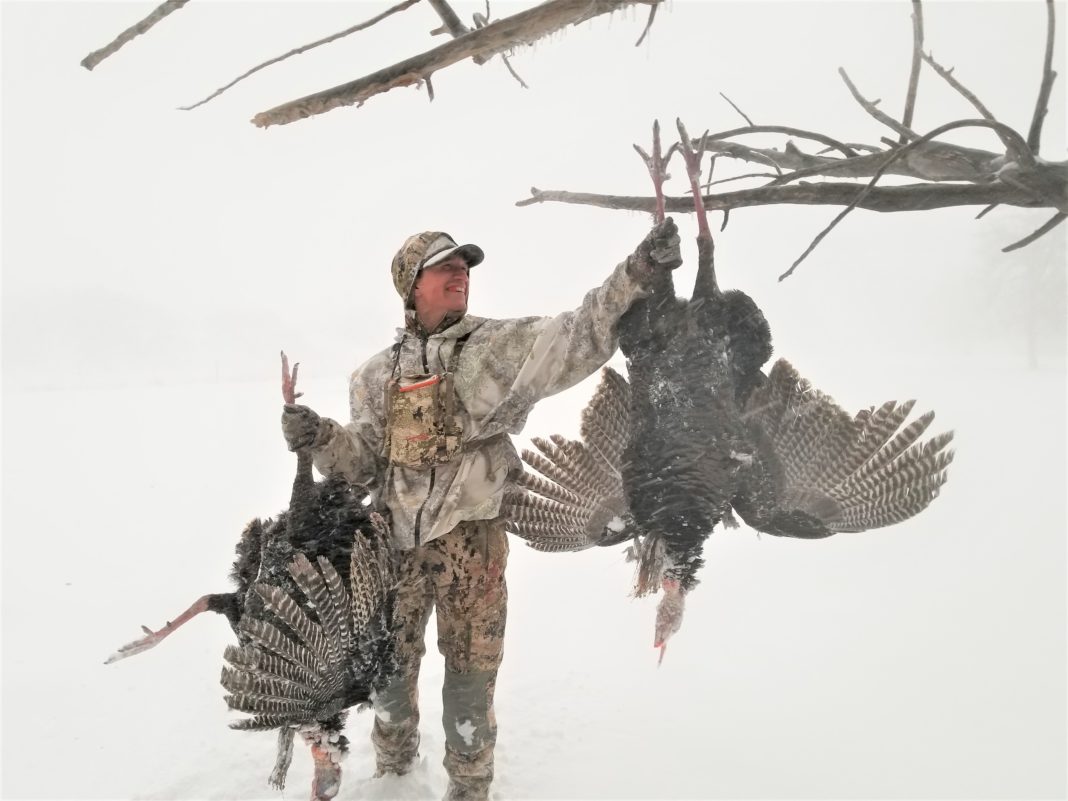


![Idiots Disturb Hunter: How Would You Have Handled It? [VIDEO]](/wp-content/uploads/2015/10/DSC00110-e1474487693878-100x70.jpg)
![Albino Buck Shocked to Shed His Antlers [VIDEO]](/wp-content/uploads/2015/10/AlbinoDeer-100x70.jpg)